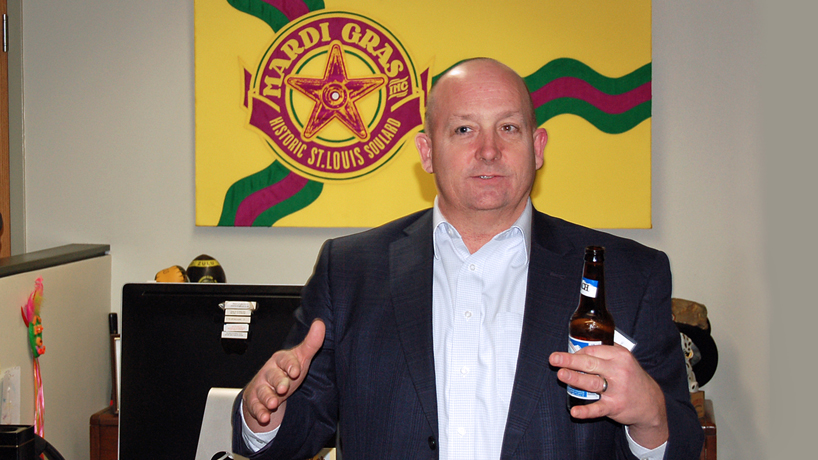
Alumnus Tim Lorson discusses the history and breadth of St. Louis’ annual Mardi Gras celebration during a Jan. 26 event sponsored by the UMSL Office of Alumni Engagement and Business Alumni Chapter. (Photo by Bob Samples)
What started as a house party on Russell Boulevard in the Soulard neighborhood in 1980 has blossomed into the second largest Mardi Gras celebration in the United States – and graduates of the University of Missouri–St. Louis deserve much of the credit.
Meeting in the offices of Mardi Gras Inc. on Jan. 26, UMSL alumni learned about the history and current operations of the festival that now includes 13 events spread over eight weeks and has a $25-million-a-year economic impact on the region. The presentation was part of a new series planned by the Office of Alumni Engagement and Business Alumni Chapter, focusing on businesses and organizations with strong UMSL connections.
The organization’s executive director, Tim Lorson, BA communication 1992, told his fellow UMSL alumni that Mardi Gras events this year began on Jan. 6 with the 12th Night celebration and end on Feb. 28 with Fat Tuesday. Overall, organizers estimate the activities will attract several hundred thousand people – with about 25 percent of those individuals traveling more than 100 miles.
The party started in a vacant building then owned by Hillary Clemens in 1980 and became an annual neighborhood event that grew in popularity. Lorson said the Soulard Business Association took notice of the party’s early success and eventually expanded it into a Soulard-wide celebration.
But things went sideways in 1999 when, according to Lorson, a melee between revelers and police threatened to bring the party to an end. That’s when several people stepped in to create Mardi Gras Inc., with the Mardi Gras Foundation following a few years later. Today, these two related nonprofit organizations plan and run the annual activities.
Mack Bradley, the foundation’s president, said everyone realized the Soulard Mardi Gras needed “qualified people who do event planning and oversight as a living” to proceed and grow. A few years in, Bradley said, Mardi Gras Inc. recruited Lorson to lead the operations.
“He’s made all the difference – bringing a level of professionalism and creativity that was badly needed,” Bradley said. “That was a big moment for the organization and the community.”
A major part of Lorson’s job is coordinating communications among Soulard residents, Soulard businesses [there are 43 bars in the neighborhood] and St. Louis City officials.
“We can work on problems when we know there’s a problem,” Lorson said. “Past issues arose when people weren’t talking or didn’t know who to talk to. Communications also allows us to manage expectations. ”
In addition to throwing great parties, the Mardi Gras Foundation has funded more than $450,000 in community grants since 2002 to improve area parks, streetscapes and schools.
Sounding like an “I Chose UMSL” advertisement, Lorson closed his presentation by crediting the education he received with preparing him for his current success.
“I had a lot of friends at other universities – Mizzou and Illinois. But that seemed different when I visited,” Lorson said. “UMSL was perfect for me. My grandparents were immigrants. My parents were blue-collar people who worked hard. I was a first-generation college student – like a lot of other UMSL students. People [at UMSL] had a strong work ethic. You were there to better your life.”
Joining Lorson at the presentation were several other UMSL alumni prominent in the development of the current Mardi Gras celebration, among them Brian Wahby, BSPA 1991, and Patrick McCarthy, BS AOJ 1980. Wahby helped create the duo Mardi Gras organizations and negotiate the purchase of the organizations’ current home on Dolman Street. For many years, McCarthy has organized security for the Mardi Gras celebrations.
Also attending – and catering – was Sugarfire BBQ pit master and UMSL alumnus Casey Jovick.















